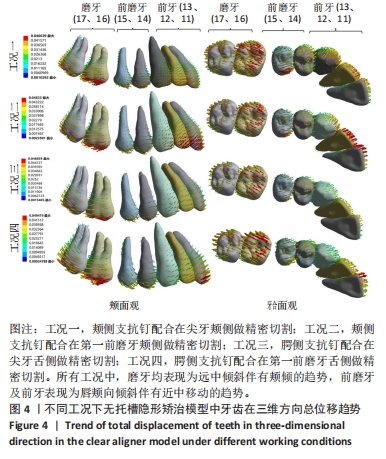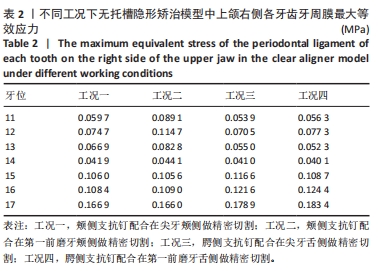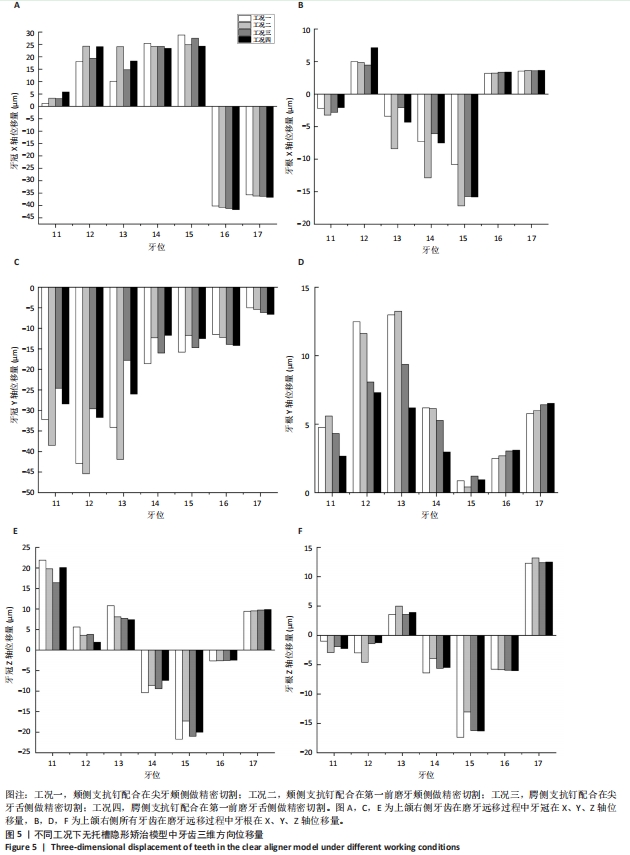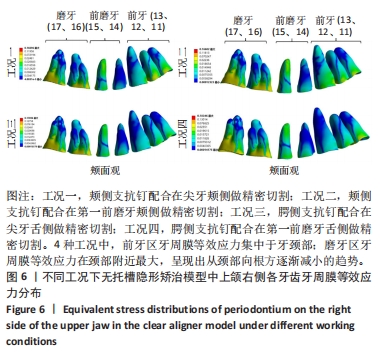Chinese Journal of Tissue Engineering Research ›› 2025, Vol. 29 ›› Issue (28): 6012-6019.doi: 10.12307/2025.474
Previous Articles Next Articles
Finite element analysis on miniscrews and hooks with different locations assisted clear aligners in maxillary molar distalization
Ye Panpan1, Xu Changxi1, Li Hui2, Zhang Yang3, Xu Xiaolin2, Wang Hongning2
- 1School of Stomatology, Binzhou Medical University, Yantai 264003, Shandong Province, China; 2Orthodontic Department, Yantai Stomatological Hospital Affiliated to Binzhou Medical University, Yantai 264001, Shandong Province, China; 3Ulsan Ship and Ocean College, Ludong University, Yantai 264025, Shandong Province, China
-
Received:2024-05-07Accepted:2024-07-08Online:2025-10-08Published:2024-12-07 -
Contact:Wang Hongning, MS, Associate chief physician, Orthodontic Department, Yantai Stomatological Hospital Affiliated to Binzhou Medical University, Yantai 264001, Shandong Province, China -
About author:Ye Panpan, Master candidate, School of Stomatology, Binzhou Medical University, Yantai 264003, Shandong Province, China -
Supported by:Yantai Science and Technology Innovation Development Plan Project, No. 2023YD044 (to WHN)
CLC Number:
Cite this article
Ye Panpan, Xu Changxi, Li Hui, Zhang Yang, Xu Xiaolin, Wang Hongning. Finite element analysis on miniscrews and hooks with different locations assisted clear aligners in maxillary molar distalization[J]. Chinese Journal of Tissue Engineering Research, 2025, 29(28): 6012-6019.
share this article
Add to citation manager EndNote|Reference Manager|ProCite|BibTeX|RefWorks

2.1 模型验证结果 由于临床中主要选择颊侧支抗钉联合在尖牙处做精密切割,辅助无托槽隐形矫治器远移上颌磨牙,所以选用工况一模型进行验证。工况一中各牙齿在三维方向上的位移趋势为:磨牙主要表现为远中倾斜移动伴有轻微颊倾,前磨牙主要表现为近中移动并伴有颊倾,前牙主要表现为唇向移动,这与多项临床研究一致[23-24]。通过分析工况一各牙齿三维方向移动值及牙周膜最大等效应力结果,此次研究结果与JIA等[15]、GUO等[25]、JI等[26]的体外生物力学实验数据相近。综合以上结果说明此次研究的模型具有有效性。 2.2 不同工况下无托槽隐形矫治模型中牙齿三维方向位移量 不同工况下无托槽隐形矫治模型中牙齿三维方向位移云图,见图4。由图可以发现,在所有工况中,磨牙均表现为远中颊侧倾斜的移动趋势,前磨牙及前牙表现为颊舌向倾斜伴有近中的移动趋势,牙齿整体呈现出一定的扩弓倾向。为了进一步量化分析,依据测量标记点取值计算后绘制牙齿三维方向位移量直方图,见图5。"


2.2.1 上颌磨牙 在4种工况中,第二磨牙表现出向远中颊倾伴有压低的移动趋势,第一磨牙表现出向远中颊倾伴有伸长的移动趋势。近远中向上,工况四条件下第一、二磨牙表现出最大的牙冠远移量,分别为41.7,36.8 μm;工况一条件下第一、二磨牙远移量最少,分别为40.2,35.7 μm。根据图5A可以看出,当组间比较时,磨牙的远移量大小表现为:工况三 > 工况一,工况四 > 工况二;当组内比较时,磨牙的远移量大小表现为工况二 > 工况一,工况四 > 工况三。结果表明,相较于颊侧支抗钉,腭侧支抗钉可增加上颌磨牙远中移动量;相较于在尖牙处做精密切割,在第一前磨牙处做精密切割可增加上颌磨牙远中移动量。 颊舌向上,工况一下磨牙颊向移动量最小,工况四的磨牙颊向移动量最大,根据图5C可知工况一到工况四的磨牙牙冠颊倾逐渐增大。 垂直向上,从图5E可以看出,工况一到工况四的上颌第一磨牙伸长量逐渐减小,上颌第二磨牙压低量逐渐增大。 2.2.2 上颌前磨牙 在4种工况中,上颌第一、二前磨牙均表现出近中颊倾并伴有伸长的移动趋势。近远中向上,工况一条件下第一、二前磨牙表现出最大近中移动量,分别为25.4,28.8 μm;工况四条件下第一、二前磨牙表现出最小近中移动量,分别为23.4,24.3 μm。从图5A可知,组间比较时,前磨牙的近中移动效应量大小表现为:工况一 > 工况三,工况二 > 工况四;组内比较时,前磨的近中移动效应量大小表现为:工况一 > 工况二,工况三 > 工况四。结果表明,当支抗钉位于腭侧或精密切割位于第一前磨牙时,前磨牙近中移动量均会减小。 颊舌及垂直向上,当支抗钉位于腭侧或精密切割位于第一前磨牙时,前磨牙的颊倾、伸长量随之减小。 2.2.3 上颌前牙 在4种工况中,前牙均表现为近中唇倾并伴有压低的移动趋势,其中侧切牙唇向移动量最大。唇舌向上,工况二条件下前牙表现出最大的唇向移动量,中切牙、侧切牙、尖牙唇向移动量分别为38.5,45.4,41.9 μm;工况三条件下前牙表现出最小的唇向移动量,分别为24.6,29.6,17.8 μm。根据图5A可以看出,组间比较时,前牙的唇向移动量大小表现为:工况一 > 工况三,工况二 > 工况四;组内比较时,前牙的唇向移动量大小表现为:工况一 < 工况二,工况三 < 工况四。结果表明,腭侧支抗钉能保护前牙支抗,减小前牙唇倾量;当精密切割位于尖牙更有利于减少前牙唇倾量。 近远中向上,从图5A可知,前牙均呈现轻微的近中移动趋势。 垂直向上,根据图5E可知,工况一到工况四的前牙压低量呈现逐渐降低的趋势,即当支抗钉位于腭侧或精密切割位于第一前磨牙时,前牙的压低量均降低。 2.3 牙周膜应力分析 为深入研究牙齿移动过程中的生物力学并评估牙根吸收的潜在风险,分析了磨牙远移过程中右上颌各牙齿牙周膜的最大等效应力及应力分布情况。上颌右侧各牙齿牙周膜最大等效应力及应力分布图,如表2、图6所示。 "


2.3.1 前牙 根据图6可以看出,4种工况中,前牙区牙周膜等效应力集中于牙颈部。根据表2可知,在前牙中,侧切牙牙周膜最大等效应力最大;4种工况中,工况三条件下前牙牙周膜最大等效应力值最小,工况二条件下前牙牙周膜最大等效应力值最大。组间比较时,前牙牙周膜等效应力大小表现为:工况一 > 工况三,工况二 > 工况四;组内比较时,前牙牙周膜等效应力大小表现为工况一 < 工况二,工况三 < 工况四。结果表明,使用颊侧支抗时,上颌前牙承受更大的反作用力,因此牙周膜表现出更大的最大等效应力值;腭侧支抗能减少前牙牙周膜应力;当精密切割位于第一前磨牙时会增加前牙牙周膜应力。 2.3.2 磨牙 根据图6可以看出,4种工况中,磨牙区牙周膜等效应力在颈部附近最大,呈现出从颈部向根方逐渐减小的趋势。从表2可以看出,工况四条件下上颌第一、二磨牙表现出最大的应力值,工况一条件下上颌第一、二磨牙表现出最小的应力。组间比较时,磨牙区牙周膜最大等效应力大小表现为:工况一 < 工况三,工况二 < 工况四;组内比较时,磨牙区牙周膜最大等效应力大小主要表现为:工况二 > 工况一,工况四 > 工况三。结果表明,当支抗钉位于腭侧或精密切割靠后时,磨牙牙周膜受力增大。"

| [1] CHENG L, FENG Z, HAO Z, et al. Molar distalization in orthodontics: a bibliometric analysis. Clin Oral Investig. 2024;28(2):123. [2] WEIR T. Clear aligners in orthodontic treatment. Aust Dent J. 2017;62 Suppl 1:58-62. [3] RAVERA S, CASTROFLORIO T, GARINO F, et al. Maxillary molar distalization with aligners in adult patients: a multicenter retrospective study. Prog Orthod. 2016;17:12. [4] 经典,王瑞清,房兵.口腔正畸生物力学的研究进展[J].医用生物力学,2023,38(5):864-873. [5] 任玉仲秀,张继武,马俐丽,等.无托槽隐形矫治技术推上颌第二磨牙向远中的三维有限元分析[J].中华口腔正畸学杂志,2018, 25(2):108-112. [6] BOWMAN S J, CELENZA F, SPARAGA J, et al. Creative adjuncts for clear aligners, part 1: class II treatment. J Clin Orthod. 2015; 49(2):83-94. [7] 刘洪,牟雁东,于晓光,等.口腔正畸治疗中微型种植体支抗的稳定和安全性[J].中国组织工程研究,2016,20(8):1159-1164. [8] 任亚男,宋保龙,封颖丽,等.无托槽隐形矫治器结合微种植体支抗远移上颌磨牙效率的三维重叠研究 [J].中华口腔正畸学杂志, 2018,25(2):92-97. [9] 马静,赵红芳,叶茜,等.微螺钉种植体支抗辅助全牙列整体远移的研究进展[J].兰州大学学报(医学版),2021,47(6):96-101. [10] PARK HS, BAE SM, KYUNG HM, et al. Simultaneous incisor retraction and distal molar movement with microimplant anchorage. World J Orthod. 2004;5(2):164-171. [11] AL AMRI MS, SABBAN HM, ALSAGGAF DH, et al. Anatomical consideration for optimal position of orthodontic miniscrews in the maxilla: a CBCT appraisal. Ann Saudi Med. 2020;40(4):330-337. [12] KOOK YA, BAYOME M, TRANG VT, et al. Treatment effects of a modified palatal anchorage plate for distalization evaluated with cone-beam computed tomography. Am J Orthod Dentofacial Orthop. 2014;146(1):47-54. [13] XIN Y, WU Y, CHEN C, et al. Miniscrews for orthodontic anchorage: analysis of risk factors correlated with the progressive susceptibility to failure. Am J Orthod Dentofacial Orthop. 2022; 162(4):e192-e202. [14] PARK J, CHO HJ. Three-dimensional evaluation of interradicular spaces and cortical bone thickness for the placement and initial stability of microimplants in adults. Am J Orthod Dentofacial Orthop. 2009;136(3):314.e1-315. [15] JIA L, WANG C, LI L, et al. The effects of lingual buttons, precision cuts, and patient-specific attachments during maxillary molar distalization with clear aligners: Comparison of finite element analysis. Am J Orthod Dentofacial Orthop. 2023;163(1):e1-e12. [16] OH S, CHOI YK, KIM SH, et al. Biomechanical analysis for different mandibular total distalization methods with clear aligners: A finite element study. Korean J Orthod. 2023;53(6):420-430. [17] LIU X, CHENG Y, QIN W, et al. Effects of upper-molar distalization using clear aligners in combination with Class II elastics: a three-dimensional finite element analysis. BMC Oral Health. 2022;22(1):546. [18] 王诗语,黄钖钖,刘浩,等.不同牙弓形态和第二前磨牙缺失对上颌磨牙远移中支抗的影响[J].中国组织工程研究,2024,28(28): 4541-4546. [19] 杨建浩,韩璐,李亚茹,等.颧下嵴区微植体不同高度支抗远移上牙列位移的生物力学分析[J].中国组织工程研究,2018,22(10): 1523-1528. [20] LIU H, WU X, YANG L, et al. Safe zones for miniscrews in maxillary dentition distalization assessed with cone-beam computed tomography. Am J Orthod Dentofacial Orthop. 2017;151(3):500-506. [21] LEO M, CERRONI L, PASQUANTONIO G, et al. Temporary anchorage devices(TADs)in orthodontics:review of the factors that influence the clinical success rate of the mini- implants. Clin Ter. 2016;167(3): e70-e77. [22] 林泉宏,赵桂芝,柯杰.微种植体支抗整体远中移动下牙列的研究进展[J].北京口腔医学,2015,23(6):355-357. [23] RAVERA S, CASTROFLORIO T, GARINO F, et al. Maxillary molar distalization with aligners in adult patients: a multicenter retrospective study. Prog Orthod. 2016;17:12. [24] MOHAMED RN, BASHA S, AL-THOMALI Y. Maxillary molar distalization with miniscrew-supported appliances in Class II malocclusion: A systematic review. Angle Orthod. 2018;88(4):494-502. [25] GUO R, LAM XY, ZHANG L, et al. Biomechanical analysis of miniscrew-assisted molar distalization with clear aligners: a three-dimensional finite element study. Eur J Orthod. 2024;46(1):cjad077. [26] JI L, LI B, WU X. Evaluation of biomechanics using different traction devices in distalization of maxillary molar with clear aligners: a finite element study. Comput Methods Biomech Biomed Engin. 2023;26(5): 559-567. [27] ZHOU X, GAN Y, XIONG J, et al. A Method for Tooth Model Reconstruction Based on Integration of Multimodal Images. J Healthc Eng. 2018;2018:4950131. [28] 王勇.口内数字印模技术[J].口腔医学,2015,35(9):705-709,743. [29] 朱玉佳,蒋博,孙玉春,等.口腔三维冠根整合模型构建方法的研究进展[J].中华口腔医学杂志,2020,55(4):280-280. [30] 陈妍曲,唐敏,黄旋平,等.高精度三维整合牙颌模型个体化微种植体手术导板的计算机辅助设计与制作[J].中国组织工程研究, 2018,22(10):1529-1533. [31] TAKAHASHI N, KITAGAMI T, KOMORI T. Behaviour of teeth under various loading conditions with finite element method. J Oral Rehabil. 1980;7(6):453-461. [32] ELSHAZLY TM, BOURAUEL C, ALDESOKI M, et al. Computer-aided finite element model for biomechanical analysis of orthodontic aligners. Clin Oral Investig. 2023;27(1):115-124. [33] DERMAUT LR, KLEUTGHEN JP, DE CLERCK HJ. Experimental determination of the center of resistance of the upper first molar in a macerated, dry human skull submitted to horizontal headgear traction. Am J Orthod Dentofacial Orthop. 1986;90(1):29-36. [34] KE Y, ZHU Y, ZHU M. A comparison of treatment effectiveness between clear aligner and fixed appliance therapies. BMC Oral Health. 2019;19(1):24. [35] LI L, GUO R, ZHANG L, et al. Maxillary molar distalization with a 2-week clear aligner protocol in patients with Class II malocclusion: A retrospective study. Am J Orthod Dentofacial Orthop. 2023;164(1): 123-130. [36] MIN HJ,KIM TW.Biomechanical considerations in treatment with miniscrew anchorage.Part 1: the sagittal plane. J Clin Orthod. 2008; 42(6):329-337. [37] LEE SK, ABBAS NH, BAYOME M, et al. A comparison of treatment effects of total arch distalization using modified C-palatal plate vs buccal miniscrews. Angle Orthod. 2018;88(1):45-51. [38] MCCORMACK SW, WITZEL U, WATSON PJ, et al.The biomechanical function of periodontal ligament fibres in orthodontic tooth movement. PLoS One. 2014;9(7):e102387. [39] VIECILLI RF, BURSTONE CJ. Ideal orthodontic alignment load relationships based on periodontal ligament stress. Orthod Craniofac Res. 2015;18 Suppl 1:180-186. [40] MAO B, TIAN Y, XIAO Y ,et al. The effect of maxillary molar distalization with clear aligner: a 4D finite-element study with staging simulation. Prog Orthod. 2023;24(1):16. |
| [1] | Xu Hao, Ding Lu, Li Xiao. Investigating the effect of the mechanical wear on abutment screw in Morse taper connection implant implant system by using finite element analysis [J]. Chinese Journal of Tissue Engineering Research, 2025, 29(在线): 1-9. |
| [2] | Li Liangkui, Huang Yongcan, Wang Peng, Yu Binsheng. Effect of anterior controllable anteriodisplacement and fusion on vertebrae-ossification of posterior longitudinal ligament complex and implants: a finite element analysis [J]. Chinese Journal of Tissue Engineering Research, 2025, 29(9): 1761-1767. |
| [3] | Xu Biao, Lu Tan, Jiang Yaqiong, Yin Yujiao. Xu Biao, Lu Tan, Jiang Yaqiong, Yin Yujiao [J]. Chinese Journal of Tissue Engineering Research, 2025, 29(9): 1768-1774. |
| [4] | Zhou Jinhai, Li Jiangwei, Wang Xuquan, Zhuang Ying, Zhao Ying, Yang Yuyong, Wang Jiajia, Yang Yang, Zhou Shilian. Three-dimensional finite element analysis of anterior femoral notching during total knee arthroplasty at different bone strengths [J]. Chinese Journal of Tissue Engineering Research, 2025, 29(9): 1775-1782. |
| [5] | Chen Xi, Tang Tao, Chen Tongbing, Li Qing, Zhang Wen. Mechanical stability of intertrochanteric fracture of femur with different internal fixation systems [J]. Chinese Journal of Tissue Engineering Research, 2025, 29(9): 1783-1788. |
| [6] | Li Shuai, Liu Hua, Shang Yonghui, Liu Yicong, Zhao Qihang, Liu Wen. Stress distribution on the maxilla when wearing the Twin-block appliance for Class II malocclusion [J]. Chinese Journal of Tissue Engineering Research, 2025, 29(5): 881-887. |
| [7] | Zhou Zonghao, Luo Siyang, Chen Jiawen, Chen Guangneng, Feng Hongchao. Finite element analysis of bioabsorbable plates versus miniature titanium plates in mandibular fracture fixation in different bone qualities [J]. Chinese Journal of Tissue Engineering Research, 2025, 29(4): 818-826. |
| [8] | Chen Yilong, Zhang Xu, Li Hong. Mechanical analysis of fiber post combined with different crown restorations for endodontically treated non-carious cervical lesions [J]. Chinese Journal of Tissue Engineering Research, 2025, 29(4): 866-871. |
| [9] | Zhuang Yan, Wang Xinyu, Cao Yilin, Ding Yuanxin, Wang Jiaqi, Yu Miao, Luan Chunyang, Ding Yuansheng. Three-dimensional finite element analysis of personalized orthodontic devices for 3D printed maxillary single-rooted rotated tooth [J]. Chinese Journal of Tissue Engineering Research, 2025, 29(30): 6409-6415. |
| [10] | Akliya·Anwar, Nafisa·Gupur, Baibugafu·Yelisi, Zilalai·Gulaiti, Guzalnur·Emrayim, Nijat·Tursun. Dynamic stress analysis of maxillary sinus lifting without bone grafting and with immediate loading after bone grafting [J]. Chinese Journal of Tissue Engineering Research, 2025, 29(30): 6416-6425. |
| [11] | Su Dejun, Dong Wanpeng, Dong Yuefu, Zhang Jichao, Zhang Zhen. Design of asymmetric prosthesis and mechanical analysis of total knee arthroplasty [J]. Chinese Journal of Tissue Engineering Research, 2025, 29(3): 510-516. |
| [12] | Wang X, Wang Hm, Chen Sh, Feng Tx, Bu Hm, Zhu Lg, Chen Dd, Wei X. Stress and morphological characteristics of intervertebral foramen of cervical rotation-traction manipulation for treating cervical spondylotic radiculopathy: a three-dimensional finite element analysis [J]. Chinese Journal of Tissue Engineering Research, 2025, 29(3): 441-447. |
| [13] | Zhao Yuxin, Liang Liang, Jin Feng, Xu Yangyang, Kang Zhijie, Fang Yuan, He Yujie, Wang Xing, Wang Haiyan, Li Xiaohe. Establishment and stress analysis of a finite element model for adolescent cervical disc herniation [J]. Chinese Journal of Tissue Engineering Research, 2025, 29(3): 448-454. |
| [14] | Li Zhenggang, Shang Xuehong, Wu Zhang, Li Hong, Sun Chaojun, Chen Huadong, Sun Zhe, Yang Yi. Finite element analysis of three internal fixation modalities for treatment of Pauwels type III femoral neck fractures under different loading conditions [J]. Chinese Journal of Tissue Engineering Research, 2025, 29(3): 455-463. |
| [15] | Liu Mengfei, Chen Gang, Shi Yihan, Zeng Lin, Jiang Kan, Yilihamujiang•Wusiman. Finite element analysis of optimization of femoral prosthesis implantation position in unicompartmental knee arthroplasty in osteoporotic patients [J]. Chinese Journal of Tissue Engineering Research, 2025, 29(3): 464-470. |
| Viewed | ||||||
|
Full text |
|
|||||
|
Abstract |
|
|||||



